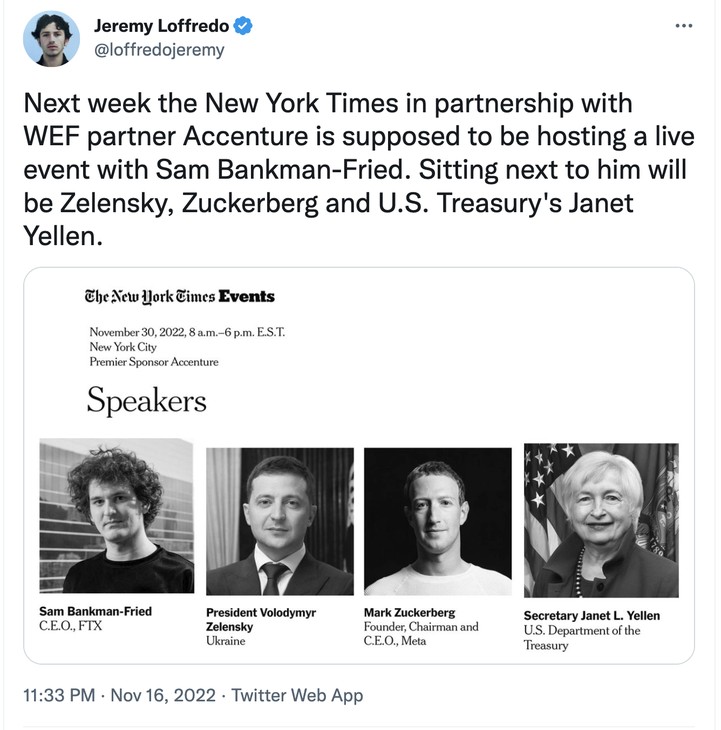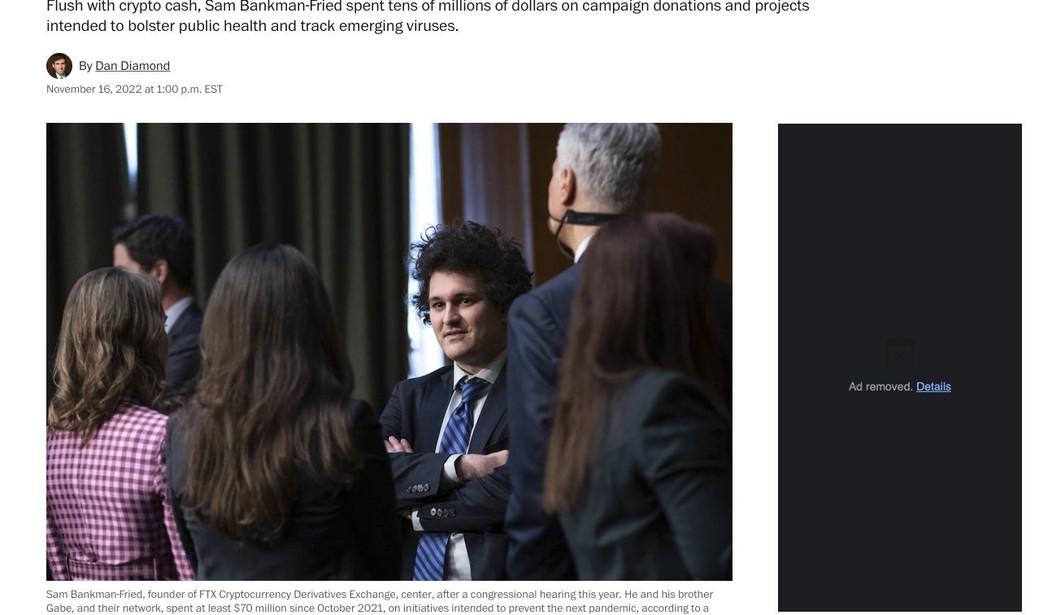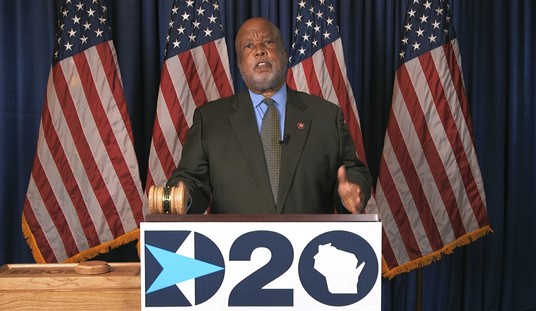I ran across a couple of fascinating stories about the FTX cryptocurrency scandal. As you probably recall, with the collapse of FTX the second largest donor to the Democrat Party after George Soros was revealed to be a complete fraud, having stolen vast sums of money from both his investors and his clients. He poured $40 million into the Democrats’ campaigns, and promised a billion more in 2024.
Two rather interesting wrinkles to the story came up–the first about how Sam Bankman-Fried (SBF), the mastermind behind the fraud, became so rich and powerful so quickly (he went from a nobody to a billionaire power broker in basically 3 years)–and the second one about how he really saw his rise to power and how he scammed the Elite™ into buying his crap.

The first story comes via Ashley Rindsberg at Tablet Magazine. I actually chatted with Ashley before I decided to write about his post because he did all the work and I don’t want to take credit for his excellent reporting. So note that: Ashley deserves all the credit for the reporting.
Rindsberg’s story gives a revealing behind-the-scenes look at how a fraud can rise to power so quickly, and it boils down to this: you can bribe reporters, major corporations, politicians, and stars to look the other way while you rape and pillage. Small time crooks are crushed, but if you are big enough and free enough with your dough you can buy credibility with just about anybody. Including, for instance, Forbes:
It’s not that they didn’t know or not know: they simply didn’t care a whit whether SBF was a total fraud as long as they got their share of the loot:
One of the most striking things about the collapse of crypto exchange FTX, once counted among the world’s largest, is the extent to which it caught the supposed watchdogs of the tech industry by surprise. How could Sam Bankman-Fried, the brainiac financial visionary, crowned earlier this year the “crypto emperor” by The New York Times, have steered his armada of crypto firms into the rocks so recklessly? With allegations of an enormous, brazen fraud lingering, the first place to look is at the central role of the media in this fiasco. Through an almost endless churn of fawning coverage, the news media turned an inexperienced—and, it seems, ethically deranged—trader into the second coming of Warren Buffett.
They literally did call him the second coming of Warren Buffett, who has a decades’ long track record of delivering results. SBF was a scammer with a sketchy backstory and a good PR strategy. But Buffett, while politically friendly to the Democrats, doesn’t have a habit of throwing his money around like a drunken sailor, while SBF was fun and profitable to hang out with.
Over the past two years, Bankman-Fried cultivated the media lavishly, if not carefully. Drawing on what then seemed like an unlimited pool of cash, SBF (as we’ll call the mythologized version of the real person) dispersed investments, advertising dollars, sponsorships, and donations to key news outlets—including ProPublica, Vox, Semafor, and The Intercept—with extraordinary effectiveness.
Bankman-Fried’s head has filled the frame of the most coveted business news covers in the world, including Fortune (“The next Warren Buffett?”) and Forbes (“Only Zuck has been as rich (23 billion) this young (29)!”). CNBC star Jim Cramer once compared Bankman-Fried, who has been active in crypto finance for only a handful of years, to John Pierpont Morgan, the giant of industry who worked in banking for nearly four decades before striking out on his own.
Remarkably, some major news outlets have continued to round the edges of the SBF myth, even after the discovery of at least a billion-dollar hole in FTX’s books, the assets seeming to vanish into the crypto ether. This week, Twitter erupted in outrage when The New York Times published what many have described as a “puff piece” on Bankman-Fried, whose whereabouts remain unknown.
I actually wrote about the Times’ puff piece yesterday because it was so ridiculously over the top it needed ridicule. SBF is a massive Democrat donor, so they “rounded the edges” as Rindsberg kindly put it. No massive Democrat donor can be that bad, can they?
Once SBF hosted a conference with Blair and Clinton it was obvious he wasn’t on the side of freedom. That’s if you hadn’t noticed all the red flags before. And all his philanthropy talk had a very Bill Gates vibes 🤢 pic.twitter.com/49S6mbKGVg
— Diego Cryptodona (@DiegoCryptodona) November 10, 2022
The Times’ latest puff piece–written after the collapse of FTX–is far harsher than anything they have written before. They have to boil the frog on this one because it turns out that the New York Times helped make SBF the crypto-kingpin that launched his wealth temporarily into the stratosphere. In effect, they helped make this fraudster into the massive Democrat donor he turned out to be. So rather than tear him apart as they would some other scammer, they handle him with kid gloves and ease us into the idea that he wasn’t quite as smart as they told us he was.
A May 2022 article by the same writer, The New York Times’ David Yaffe-Bellany, titled “A Crypto Emperor’s Vision: No Pants, His Rules,” jump-cuts from rapt audiences “roaring” with laughter at Bankman-Fried’s wit to his penchant for living “modestly” (in a $40 million Bahamas penthouse) to his chummy relationship with Tom Brady that purportedly began with Brady approaching the unassuming Bankman-Fried at a party to talk crypto.
In its flattery, the 3,500-word Times article flipped the famous fable about a naked emperor alluded to in the piece’s headline; rather than showing a naked emperor who thinks he’s elegantly clothed, it paints a picture of a figure we might all consider larger than life but who, by the Times’ account, is just a regular do-gooder whose smarts led him, almost haphazardly, to invent a proprietary money-printing machine.
Far from a one-off, the May Times piece was the culmination of a drumbeat of coverage by the paper that, collectively, helped to create the myth of SBF as “an uncannily sharp altruistic billionaire,” as Vox recently described him. A narrative of this scope, especially one that lacks substance to this degree, is never the product of an article or two, or even of a few dedicated news cycles. Rather, it’s the result of sustained, coordinated effort.
How? Why? It can’t just be that the Times was in on the scam all along? Is it really that simple?
Of course not. They weren’t exactly part of the scam–they were just indifferent about whether it was real or a scam to begin with. SBF was a convenient tool of the Establishment, deeply connected, overflowing with cash for all the right things, and by God he spread that money around to all the right people. The Times helped create SBF the hero because SBF the hero was good for the Times’ real constituency: the Establishment™. They needed an SBF, so they created him.
As you can see from the Washington Post story image that I used for this piece, SBF even roped in the COVID pandemic to help sell his image, and they are still claiming to buy that he cared. FTX falls! COVID will never be cured!
The famously acerbic Times tech columnist Kara Swisher quoted SBF approvingly, noting “Sam Bankman-Fried was right when he pointed to the unbanked and those left out of the system: ‘The [crypto] industry has the potential to improve a lot of people’s lives.’” A July Dealbook interview gave Bankman-Fried free rein to opine on trading crypto derivatives. Another Times piece, which cited SBF’s “penchant for haphazardly tied shoes and company-branded T-shirts,” focused on an FTX Super Bowl commercial featuring Larry David.
With all of the puff pieces from the press, there was apparently little interest in investigating SBF’s web of interlocking firms. A number of high profile outlets best known for investigative reporting took money from Bankman-Fried—in some cases money earmarked to fund investigative journalism—and yet did little, it appears, to investigate the source of those funds.
This was the case with a $5 million pledge to ProPublica from Bankman-Fried’s family foundation, Building a Stronger Future. Vox, which published a March 2021 interview with Bankman-Fried, introduced the FTX founder by praising his “civic-mindedness,” which was guided by an algorithmlike statement of purpose: “Make a tremendous amount of money by any means necessary. Then give it all away by the best means possible.” Perhaps their praise paid off: In a recent article on the fall of SBF, Vox mentions—albeit buried in the form of a parenthetical “Full Disclosure” in the middle of the piece—that they had receieved an undisclosed sum from Bankman-Fried’s foundation. (Vox and ProPublica did not respond to requests for comment.)
Semafor, the new publication led by former New York Times media columnist Ben Smith, similarly received an unspecified investment from Bankman-Fried. Notably, Semafor prominently publicized this informationin a piece about Matt Yglesias’ and Nate Silver’s refusal to join a different venture funded by SBF.
Pay off ProPublica and Vox and you can pretty much say or do anything you want. Get Larry David and Tom Brady and the sky is the limit. Appear on stage with admiring Tony Blair and Bill Clinton–both of whom love them some money–and credibility oozes from your pores.
Key to this strategic approach was Bankman-Fried’s exceptional ability to continually create fresh headlines about himself and his company. One of the most important tactics he used to do this was the creation of top-tier brand partnerships that would drive headlines. FTX’s relationships with Mercedes’ F1 team, naming rights negotiated with the Miami Heat, stage-sharing with Bill Clinton and Tony Blair (a pair not usually known for their altruism), the launch of an FTX gaming unit, the Larry David Super Bowl Ad—each one represented another PR opportunity that would generate dozens of headlines. With so much news real estate devoted to breathlessly boosting the latest FTX deal, sponsorship, or main-stage appearance, there was hardly room left over for investigations—or even for a critical op-ed.
Perhaps the most ironic moment of media myth-making was Fortune’s “Warren Buffett” cover story from this past August. Despite the question mark included in the copy on the cover—“Is Sam Bankman-Fried the next Warren Buffett?”—the phrase was not a question but a statement. While Buffett and his longtime business partner Charlie Munger have said time and again that their success came with years of patience, Fortune crowned Bankman-Fried the next Buffett seemingly because he’d become so rich so quickly.
Only months before the Fortune cover, another business media heavyweight had put Bankman-Fried on its cover. The 2021 Forbes 400 list annotated its cover image of SBF with an unnervingly prescient quote from Bankman-Fried: “I got involved in crypto without any idea what crypto was.” If there was a single tipping point in the creation of the SBF myth, this was it. Beyond mere inclusion on the Forbes 400 list (the one Kanye West frequently invoked in his recent antisemitic tirades, and which made headlines for reincluding Trump), Bankman-Fried was now the very face of America’s most hallowed symbol of financial success.
I harp on the importance of Narrative™ to the Left all the time. SBF mastered the most important tool to build one: enlist the media, the glitterati, and the “experts” and get them all to sing off the same song sheet. By doing so you create an alternate reality that is even more powerful than Steve Jobs’ famous “reality distortion field.” Jobs could sell freezers to Eskimos, but at least it would be a SubZero and look really cool.
SBF was selling vaporware and pocketing the loot, all with the help of the Elite™. Most of us would imagine–wrongly–that the stamp of approval from the Establishment™ would be the result of some due diligence, but most of us would be wrong. Anthony Fauci is SBF and SBF is Anthony Fauci: as long as the big boys agree, they are demigods. No substance required.
Sam Bankrupt-Fraudpic.twitter.com/CkN0XUnC7v
— Fintwit (@fintwit_news) November 12, 2022
Go read the rest of Ashley’s piece, because it is that good. I’ve covered the high points, but as I implied above there is a second wrinkle to the story. SBF agreed to give his side of the story to Vox–one of those publications that he so generously funded and from which he has gotten a lot of great coverage.
He did so, as any good millennial would, through iMessage. Vox has helpfully provided some screenshots.
SBF gained his reputation by continually claiming to be a philanthropist who is making tons of money just to do good by giving it away. In fact, much of the positive press he has received was focused on his philanthropic focus while emphasizing that he was able to be such a super awesome selfless guy because he was a super awesome financial genius.
He pretty much admits, unsurprisingly, that it was all a front. Public relations. Basically it was all about the dough. And who could possibly be surprised by that? He was spending money hand over fist on buying politicians, sponsorships with Mercedes, the Miami Heat, and celebrities like Larry David and Tom Brady. When hundreds of millions are going out the door to the Elite, what is left for the needy?
Nobody thought to check. ProPublica got its loot, so who cares?
And that, as you guess, was exactly how the Elite™ wanted it. Some NSFW content in the screenshots, so be warned.





This is the guy who a week or two back was still getting puff pieces in all the media, getting meetings with the most powerful politicians in the world, and shelling out dough to all the right non-profits, especially those in the media space. He literally went from hero to zero in less than a week.
Everybody in the media and political world is “shocked! Shocked I tell you!” about SBF’s fall, but it too is all a scam. They may or may not have known that SBF was a fraud, but unquestionably they didn’t care a bit. He was useful to them and vice-versa. All the philanthropy, all the talk about ethics, all the contributions to the “right” people was about keeping the gravy train going.
And are any of these people victims who will lose their shirt? Not at all. The politicians got their money and elected. The celebrities got their payoffs. ProPublica and Vox banked their donations. It is only the little guy who got screwed. There were rumors that Tom Brady lost his fortune, but that too was complete BS.
This is the power of an effective Narrative™. It literally creates a reality that changes the world.
The Democrats won the Senate partly with this money. Joe Biden’s 2nd largest donor in 2020 was SBF, so he helped buy the presidency. ProPublica and Vox are wealthier and more able to push Left-wing causes. And, as of now, SBF is still free and making fun of his victims.
Lots of investors and clients though, are screwed.
BONUS HUMOR:
TikTok is too good pic.twitter.com/QUs9QmuOCs
— Jason Goldman (@goldman) November 16, 2022








